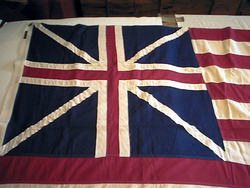Continental Colors, reproduction, 1950s.
This flag is a replica of the first national flag of the U.S. It is often incorrectly referred to as the "Grand Union Flag" although its contemporary name was "the Continental Colors."
The Continental Colors was the first national flag of the United States, although never officially recognized by the 2nd Continental Congress. Its canton bears a union of the crosses of St. George, symbolizing England, and St. Andrew, symbolizing Scotland. This indicated that Americans still professed loyalty to King George until independence was proclaimed in 1776. The field of alternating red and white horizontal stripes, a design possibly borrowed from the flag of the Sons of Liberty, expressed the unity of the 13 colonies seeking redress of their grievances against Parliament.
The Continental Colors is first known to have been raised during the siege of Boston in the winter of 1775 - 1776. However, because its canton bore the Union Jack, the British initially mistook it as a symbol of submission. The Continental Colors served the United States as a naval ensign and as a garrison flag throughout 1776 and at least until September 1777, three months after the Stars and Stripes was adopted. It received the first salute to the American Flag when the ship "Andrea Doria" was honored by Dutch authorities in the Caribbean in November 1776.









